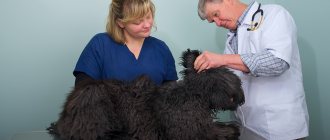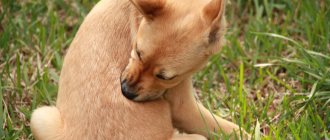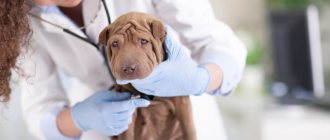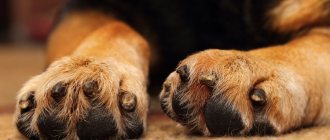Grooming is an integral part of the life of many pets. For some decorative breeds this is a necessity. Terriers and poodles will experience great discomfort in everyday life if their coats are not brushed and trimmed regularly. But many other dogs really don’t like to part with their fur coat.
Owners shorten the fur of animals for various reasons. Someone wants to make life easier for their pet during the hot summer period, while others want to make their dog stylish. In any case, a haircut is a fairly serious intervention in the dog’s daily life, which means it carries some consequences.
Many owners notice that their pets behave strangely after shortening their fur. Sometimes these are changes of an emotional nature, and sometimes strange movements or a changed gait. The animal may shake, whine and tremble. Even problems with bowel movements can be caused by unsuccessful trimming.
Your dog's ears are itchy: How to treat it at home
First you need to contact a veterinarian, ideally a veterinary dermatologist , to make a correct diagnosis. Before visiting a doctor, it is strongly recommended not to treat the animal with anything in order to avoid blurring the clinical picture.
If the owner is sure that the itching is caused by a haircut or trimming, it is necessary to lubricate the inner surface of the ear with emollients, moisturizers, or products aimed at relieving redness and irritation (see recommendations above in the article).
When visiting a veterinarian, in addition to a standard examination and history taking, the following procedures may be prescribed:
- Skin scraping.
- A swab from the ear canal.
- Taking a general or biochemical blood test.
Read other articles about dog care: How and with what to comb a dog: Trimming a dog’s nails and ears: Glands under a dog’s tail: Rules of care, problems and solutions – https://strazhchistoty.ru/cleanup/cleandogs/zhelezy-pod-hvostom- dogsaki.html
Cold
Just like in humans, shivering in dogs can be an involuntary reaction to cold. The breeds mentioned above are especially vulnerable to cold temperatures because they are very small in size and usually weigh no more than 3.1 kg. In this case, we are dealing with an instinct that helps to accelerate the flow of blood, which helps to avoid hypothermia in the dog’s body.
What to do? In autumn and winter, when walking the dog, use, for example, warm clothes for walking the dog - a sweatshirt, overalls, sweater, etc. If this happens even at home, you can turn on the heater, but it is not advisable to leave it on with the dog without supervision . It is also advisable to insulate the place where the dog rests and sleeps - use a blanket or bedding. If your dog gets wet in the rain, it would be a good idea to dry it with a hairdryer. When there are no means of insulation at hand (for example, you are on a trip), you can press the animal to you or hold it in your arms.
Recommendations for owners
It is necessary to prevent ear diseases in your pet. Avoid injury, hypothermia, and when bathing dogs, avoid getting water in the ears. If this happens, dry the ears with a towel.
You should not put anything in your dog's ear without consulting your veterinarian.
When treating the ears with cotton swabs, care must be taken not to damage the eardrum.
Statistics say that ear diseases in dogs are among the most dangerous and common ailments,
therefore, you should not postpone your visit to the doctor and let the disease take its course.
How to help your pet with grooming
The main reason for the dog’s strange behavior after procedures is most often the stress that was received in the process of communicating with the master. To save your pet from possible traumatic experiences and changes in character, you must follow some rules during the procedure:
- Start as early as possible . If you have the opportunity to work with a puppy from birth, then teach him to manipulate claws and fur from as early an age as possible. A puppy who first encounters a clipper at five weeks later tolerates it much more easily than his brothers who were cut off in adolescence. Representatives of many decorative breeds, for example, terriers, begin to become accustomed to the sensations of grooming even earlier. An important condition is to do everything carefully and with affection, showing that the operation is not dangerous and does not cause harm.
- If the need to shorten the hair arose already in adulthood , then you should treat the first procedures with special attention. It is necessary to show the dog that this is not scary and does not have any fatal consequences. During events, the dog needs to be constantly praised and reassured. It's best if the owner is nearby. Few professionals, giving the first haircut to an adult dog, will agree to completely carry out all the necessary manipulations at once. They need to be done gradually, and the fur should not be left too short, so that the animal gets used to the new sensations and does not experience much discomfort, otherwise it will perceive the trimming as a danger.
- The consequences of stress due to being in an unfamiliar place with unfamiliar people often affect the dog’s subsequent well-being. Therefore, on the first trip to a new master, it is better for the owner to be nearby so that the pet does not feel that it has been abandoned.
- Rest is necessary when staying in one static position for a long time, especially if the pet is just getting used to the procedure. An experienced groomer will give you a break and stretch a little, change your position, or even run around the room. If this is not done, the animal will begin to twitch, show impatience and even aggression. Due to sudden movement, you can accidentally damage the skin, which will also not improve the condition after the procedure.
Prevention
To prevent your dog from reacting negatively to the consequences of trimming, it is recommended to follow a few simple rules:
- Animals that are too sensitive and receptive to changes should not be cut bald immediately, but 2-3 times in order to give time to get used to new sensations and their appearance;
- for pets with very coarse hair, instead of radical trimming, it is better to perform light rolling, removing only regrown hair every 1.5–2 months and also dividing this procedure into 2–3 times;
- For representatives of breeds with floppy ears, if they are not cropped, pinch them off at the level of the torso or slightly below so that the animal does not shake its ears, breaking them until they bleed.
In any case, you need to choose the optimal cutting frequency for your pet. After all, if an overgrown dog looks untidy, then a bald dog is ugly.
Source of the article: https://usatiki.ru/sobaka-stesnyaetsya-posle-strizhki/
Viruses, parasites, diseases
If you notice, along with trembling, loss of appetite, fever and lethargy, the cause may be rooted in a viral disease - for example, panleukopenia, influenza, adenovirus, parvovirus enteritis. Such cases are often associated with vomiting, diarrhea, and unusually colored urine. In the same section we include helminthic infestation, tick bites, dirofilariasis - problems with parasitic organisms. Tremors can be caused by problems with the central nervous or cardiovascular system, or pneumonia. With pneumonia, a wet cough appears, with heart problems - a compressed and dry cough.
What to do? Call the veterinarian at home or go to the clinic.
Allergic reactions and poisoning
Typically, the easiest pattern to detect is one associated with a specific type of food or drug. Then, most likely, the dog is shaking due to an allergic reaction or poisoning. With allergies and intolerance to some substance, redness sometimes occurs. It is possible that the animal will try to scratch the place where it appeared. Poisoning can be accompanied by diarrhea, vomiting, apathy and general weakness.
What to do? Of course, it is best to stop taking the product or medication if it causes discomfort and tremors. See if the situation improves if you eliminate what your dog's body cannot tolerate. If there is no change for the better, you should consult a veterinarian. For allergies, antihistamines are often prescribed.
List of medicines for itching
Self-prescription of antipruritic drugs is strictly prohibited! Itching is primarily an external manifestation of the problem. If it is masked, then the main pathology that provokes it will progress, causing irreparable harm to the health of the animal!
Below is a list of medications that have a pronounced antipruritic effect and are used by veterinary specialists if the pet itches severely and frequently. Be sure to take into account the underlying pathology (the information is given for informational purposes only and cannot be taken as a guide to action without consulting a specialist):
- Oclacitinib (Apoquel).
- Glucocorticosteroids (Metypred, Dexa-kel, Dexa-fort, Stop-Itching, Kenalog, Polcortolon, Diprospan, Execan).
- Cyclosporine (Atopica).
- Psychotopic drugs (Gabapentin, Topiramate, Pregabalin).
- Antihistamines containing chlorpheniramine, diphehydramine, hydroxyzine, cetirizine, etc. (Diphenhydramine, Chlorphenamine, Atarax, Cetrin, Zyrtec, Clemastine, Tavegil).
- Pentoxifylline.
- Symptomatic therapy (antibiotics, fungicides, antispasmodics, vitamins, etc.).
- Omega-3,6 fatty acids (5:1).
The drugs are used strictly in veterinary dosages!
What to do if your dog constantly shakes his ears?
Look inside your pet's ears - if they are blackened from the inside, this may indicate an ear mite infestation. At an early stage of the disease, you can cure your pet yourself by purchasing special drops against these harmful insects at the pet store. Treatment of ear mites in a dog is a rather lengthy, but in most cases not unsuccessful process. In all other cases, take the animal to the doctor. The veterinarian will examine the dog, make a diagnosis and prescribe treatment. He may ask you about the presence of other animals in the house - this is due to the fact that some infections that affect the inner ear of dogs can be transmitted from one pet to another; in such cases, all animals should be treated simultaneously. Follow your veterinarian's instructions exactly and your dog will soon stop shaking his ears and feeling restless.
Which clinics should I go to?
In large cities there are highly specialized veterinary specialists. Therefore, it is advisable to visit a veterinarian specializing in veterinary dermatology.
Such specialists are available in all major clinics, such as Belyi Klyk and Zoostatus in Moscow. Clinic of A. Fillmore, clinic of Dr. Sotnikov in St. Petersburg.
Grooming is an integral part of the life of many pets. For some decorative breeds this is a necessity. Terriers and poodles will experience great discomfort in everyday life if their coats are not brushed and trimmed regularly. But many other dogs really don’t like to part with their fur coat.
Owners shorten the fur of animals for various reasons. Someone wants to make life easier for their pet during the hot summer period, while others want to make their dog stylish. In any case, a haircut is a fairly serious intervention in the dog’s daily life, which means it carries some consequences.
Many owners notice that their pets behave strangely after shortening their fur. Sometimes these are changes of an emotional nature, and sometimes strange movements or a changed gait. The animal may shake, whine and tremble. Even problems with bowel movements can be caused by unsuccessful trimming.
Tips for adapting your dog after a haircut
It is extremely important to create the most comfortable conditions after grooming so that the four-legged family member does not receive even more stress and the condition does not worsen.
To normalize the condition, you need to:
- Bath immediately to get rid of all cut hairs that can prick and irritate the skin.
- Dress in special clothes made from natural fabrics so that the pet gets used to the new sensations and does not get too cold.
- In case of severe itching, treat the animal with panthenol or chlorhexidine. They help relieve irritation that causes the animal to become strange.
- Praise and call beautiful more often. It is very important for a pet to listen to the owner's approval.
- Pay closer attention to possible contact with dangerous objects; bare skin is much easier to damage.
- When trimming for the first time or if the coat is very stiff, carry out the procedure in two passes, giving time to get used to the new length.
Treatment
Ear diseases in dogs should be treated by a veterinarian.
Before contacting a specialist, you can provide first aid to your pet, and if a person does not have the opportunity to see a doctor, then use therapy methods at home.
Otitis is treated by cleaning the ear with antibiotics,
anti-inflammatory and decongestant drugs.
Inflammation of the ear cartilage requires surgical intervention,
Therefore, at home, damaged areas are treated several times with antiseptic solutions, for example, furatsilin solution.
The hematoma also needs to be treated with antiseptic solutions (iodinol, iodine, boric acid solution); Vishnevsky ointment can be used to speed up tissue healing.
Ear sores are treated with birch tar,
iodine, iodine, hydrogen peroxide.
You can get rid of ear mites by instilling sea buckthorn oil into your ears for 20 days.
Before doing this, gently clean them with a cotton swab dipped in hydrogen peroxide.
Growths in the form of papillomas are treated with celandine juice, iodine, and peroxide solution.
Tumors and any malignant formations in dogs are treated at home with the drug "ASD-2".
This remedy strengthens the immunity of a weakened animal. The drug can be purchased at a veterinary pharmacy.
For sulfur plugs, special drops are prescribed that dissolve sulfur.
At home, you can gently treat your ears with hydrogen peroxide.
If you have any ear diseases, you should immediately contact your veterinarian. Treat the dog with medications prescribed by the doctor. Treatment with traditional methods is not always effective and can lead to serious complications.
Ear drops for dogs
There are a number of effective drugs for the treatment and prevention of ear diseases:
- "Amitrazine Forte"
- suitable drops for the treatment of demodicosis, otitis media of various types, and mycoses. They are characterized by low toxicity and have good penetrating ability. - "Aurikan"
effectively copes with various ear infections, gets rid of mites, relieves pain and inflammation. Can be used for both treatment and prevention. - "Bars"
is a broad-spectrum anti-inflammatory drug. Accelerates the healing of wounds, cuts, sores, relieves itching and pain. - "Dekta"
- ear drops with propolis. Efficacy against ticks is associated with antibacterial and anesthetic effects; they also eliminate itching and unpleasant odor. Used only for medicinal purposes. - "Oricin"
is a moderately toxic ear drug with a strong analgesic effect. Used to treat all types of otitis. - "Otibiovin"
is a broad-spectrum antibiotic for the treatment of fungal ear infections, eczema, and dermatitis. Contraindicated for use if the eardrum is ruptured. - “Otovedin”
is a low-toxic drug that eliminates not only mites, but also various inflammatory processes. - "Otoferonol"
treats otitis media of bacterial etiology. - "Otoferonol Gold"
effectively eliminates ticks. - "Otoferonol Premium"
is used for the treatment of ear scabies and tick-borne infections. The drug eliminates itching and regenerates damaged skin. - "Otodepin"
is a hygienic ear preparation for the successful treatment of external and internal otitis media, and is also effective in the treatment of ulcers, sores and hematomas. Used for both treatment and prevention. - "Surolan"
- drops for fungal and parasitic otitis media, have antihistamine, anesthetic and anti-inflammatory properties.
In order to prevent many ear diseases in dogs, the following rules must be followed:
- promptly clean your pet’s ears from dirt and wax;
- use prophylactic medications;
- avoid hypothermia;
- Avoid communication between your pet and sick relatives;
- protect your ears from getting large amounts of water into them;
- trim off excess hair in the ear area.
What pathologies are manifested by muscle tremors, how to treat them?
A dog will usually shiver if it is cold. The condition is nothing more than chills. The animal is shivering because it froze while walking in cold weather. Pets also shake after water treatments, when the temperature in the room is low for them. To prevent the dog from trembling during and after walking, he should wear warm overalls and limit the duration of walks in cold weather. After bathing, the animal's fur should be dried well with a towel or hairdryer. There are also not so harmless causes of canine muscle tremors. These include such dangerous diseases as hypoglycemia, hormonal disorders, viral diseases, helminthic infestation, and pathologies of internal organs. If they are present, other symptoms are usually associated. For example, an animal not only shakes, but also feels sick and vomits, it becomes lethargic, breathes heavily, walks poorly, and has difficulty moving its legs.
Three universal ways to relieve chronic stress
They work regardless of the cause of the stressful condition. It is advisable to use them in combination, giving preference to the method to which the dog reacts more vividly, with greater curiosity and interest.
1. Occupational therapy – we play sports, walk a lot, learn new commands, run in the forest for a stick or “prey” (you can trace a trail along the ground with a torn bag of sausage, hide a tasty piece at the end of the path and invite the dog to overcome all the tricky loops to achieve the goal).
2. New emotions, switching means meeting new people, new toys, unusual treats. Everything interesting and fundamentally new that will force the dog to explore, study, and delve into it.
3. Since it is sometimes necessary to treat stress immediately, here and now, it is possible to use mild sedatives. For example, an elderly dog is afraid of cars or firecrackers to the point of panic. She can be accustomed to the smell of a car and the sound of a rumble, but this must be done gradually, and adaptation will take more than one month. But what if you need to go now? Or is the New Year just around the corner - a time of endless explosions outside the window? An old or too nervous dog may not be able to cope (nervous breakdown, heart attack, stroke). In this case, a veterinarian will help relieve symptoms of stress. But it is important to remember that sedatives do not solve the problem, but only postpone the solution process for a while! You can't rely on pills alone if you want a healthy and happy life for your pet.











